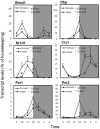Diurnal variation of hepatic antioxidant gene expression in mice
- PMID: 22952936
- PMCID: PMC3430632
- DOI: 10.1371/journal.pone.0044237
Diurnal variation of hepatic antioxidant gene expression in mice
Abstract
Background: This study was aimed to examine circadian variations of hepatic antioxidant components, including the Nrf2- pathway, the glutathione (GSH) system, antioxidant enzymes and metallothionein in mouse liver.
Methods and results: Adult mice were housed in light- and temperature-controlled facilities for 2 weeks, and livers were collected every 4 h during the 24 h period. Total RNA was isolated, purified, and subjected to real-time RT-PCR analysis. Hepatic mRNA levels of Nrf2, Keap1, Nqo1 and Gclc were higher in the light-phase than the dark-phase, and were female-predominant. Hepatic GSH presented marked circadian fluctuations, along with glutathione S-transferases (GST-α1, GST-µ, GST-π) and glutathione peroxidase (GPx1). The expressions of GPx1, GST-µ and GST-π mRNA were also higher in females. Antioxidant enzymes Cu/Zn superoxide dismutase (Sod1), catalase (CAT), cyclooxygenase-2 (Cox-2) and heme oxygenase-1 (Ho-1) showed circadian rhythms, with higher expressions of Cox-2 and CAT in females. Metallothionein, a small non-enzymatic antioxidant protein, showed dramatic circadian variation in males, but higher expression in females. The circadian variations of the clock gene Brain and Muscle Arnt-like Protein-1(Bmal1), albumin site D-binding protein (Dbp), nuclear receptor Rev-Erbα (Nr1d1), period protein (Per1 and Per2) and cryptochrome 1(Cry1) were in agreement with the literature. Furthermore, acetaminophen hepatotoxicity is more severe when administered in the afternoon when hepatic GSH was lowest.
Conclusions: Circadian variations and gender differences in transcript levels of antioxidant genes exist in mouse liver, which could affect body responses to oxidative stress at different times of the day.
Conflict of interest statement
Figures







Similar articles
-
Differential patterns in the periodicity and dynamics of clock gene expression in mouse liver and stomach.Chronobiol Int. 2012 Dec;29(10):1300-11. doi: 10.3109/07420528.2012.728662. Epub 2012 Nov 6. Chronobiol Int. 2012. PMID: 23131081
-
Dysregulation of metallothionein and circadian genes in human hepatocellular carcinoma.Chronobiol Int. 2017;34(2):192-202. doi: 10.1080/07420528.2016.1256300. Epub 2016 Dec 20. Chronobiol Int. 2017. PMID: 27997226
-
Sex differences in the circadian variation of cytochrome p450 genes and corresponding nuclear receptors in mouse liver.Chronobiol Int. 2013 Nov;30(9):1135-43. doi: 10.3109/07420528.2013.805762. Epub 2013 Aug 8. Chronobiol Int. 2013. PMID: 23926955 Free PMC article.
-
The effect of dexamethasone on clock gene mRNA levels in bovine neutrophils and lymphocytes.Vet Immunol Immunopathol. 2010 Dec 1;138(3):183-92. doi: 10.1016/j.vetimm.2010.07.017. Epub 2010 Aug 10. Vet Immunol Immunopathol. 2010. PMID: 20807668
-
Redox Homeostasis in Ocular Tissues: Circadian Regulation of Glutathione in the Lens?Antioxidants (Basel). 2022 Aug 3;11(8):1516. doi: 10.3390/antiox11081516. Antioxidants (Basel). 2022. PMID: 36009235 Free PMC article. Review.
Cited by
-
Time of day differences in the regulation of glutathione levels in the rat lens.Front Ophthalmol (Lausanne). 2024 Aug 15;4:1407582. doi: 10.3389/fopht.2024.1407582. eCollection 2024. Front Ophthalmol (Lausanne). 2024. PMID: 39211001 Free PMC article.
-
NSAID chronotherapy after impacted third molar extraction: a randomized controlled trial.Oral Maxillofac Surg. 2022 Dec;26(4):663-672. doi: 10.1007/s10006-021-01029-8. Epub 2022 Jan 22. Oral Maxillofac Surg. 2022. PMID: 35064366 Clinical Trial.
-
Drug Hepatotoxicity: Environmental Factors.Clin Liver Dis. 2017 Feb;21(1):103-113. doi: 10.1016/j.cld.2016.08.008. Epub 2016 Oct 13. Clin Liver Dis. 2017. PMID: 27842766 Free PMC article. Review.
-
Redox changes in obesity, metabolic syndrome, and diabetes.Redox Biol. 2021 Jun;42:101887. doi: 10.1016/j.redox.2021.101887. Epub 2021 Feb 4. Redox Biol. 2021. PMID: 33579666 Free PMC article. Review.
-
Nuclear Factor-Erythroid-2-Related Factor 2 in Aging and Lung Fibrosis.Am J Pathol. 2016 Jul;186(7):1712-23. doi: 10.1016/j.ajpath.2016.02.022. Am J Pathol. 2016. PMID: 27338106 Free PMC article. Review.
References
-
- Dibner C, Schibler U, Albrecht U (2010) The mammalian circadian timing system: organization and coordination of central and peripheral clocks. Annu Rev Physiol 72: 517–549. - PubMed
-
- Lim FL, Currie RA, Orphanides G, Moggs JG (2006) Emerging evidence for the interrelationship of xenobiotic exposure and circadian rhythms: a review. Xenobiotica 36: 1140–1151. - PubMed
-
- Froy O (2011) The circadian clock and metabolism. Clin Sci (Lond) 120: 65–72. - PubMed
-
- Paschos GK, Baggs JE, Hogenesch JB, FitzGerald GA (2010) The role of clock genes in pharmacology. Annu Rev Pharmacol Toxicol 50: 187–214. - PubMed
-
- Gachon F, Firsov D (2011) The role of circadian timing system on drug metabolism and detoxification. Expert Opin Drug Metab Toxicol 7: 147–158. - PubMed
Publication types
MeSH terms
Substances
LinkOut - more resources
Full Text Sources
Medical
Research Materials
Miscellaneous

